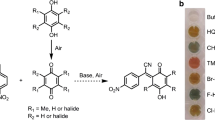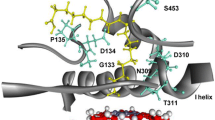Abstract
Biocatalysts are increasingly utilized in the synthesis of drugs and agrochemicals as an alternative to chemical catalysis. They are preferred in the synthesis of enantiopure products due to their high regioselectivity and enantioselectivity. Cytochrome P450 (P450) oxygenases are valuable biocatalysts, since they catalyze the oxidation of carbon–hydrogen bonds with high efficiency and selectivity. However, practical use of P450s is limited due to their need for expensive cofactors and electron transport partners. P450s can employ hydrogen peroxide (H2O2) as an oxygen and electron donor, but the reaction with H2O2 is inefficient. The development of P450s that can use H2O2 will expand their applications. Here, an assay that utilizes Amplex Red peroxidation, to rapidly screen H2O2-dependent activity of P450 mutants in cell lysate was developed. This assay was employed to identify mutants of CYP119, a thermophilic P450 from Sulfolobus acidocaldarius, with increased peroxidation activity. A mutant library of CYP119 containing substitutions in the heme active site was constructed via combinatorial active-site saturation test and screened for improved activity. Screening of 158 colonies led to five mutants with higher activity. Among improved variants, T213R/T214I was characterized. T213R/T214I exhibited fivefold higher kcat for Amplex Red peroxidation and twofold higher kcat for styrene epoxidation. T213R/T214I showed higher stability towards heme degradation by H2O2. While the Km for H2O2 and styrene were not altered by the mutation, a fourfold decrease in the affinity for another substrate, lauric acid, was observed. In conclusion, Amplex Red peroxidation screening of CYP119 mutants yielded enzymes with increased peroxide-dependent activity.
Graphic abstract












Similar content being viewed by others
Abbreviations
- P450:
-
Cytochrome P450
- HRP:
-
Horseradish peroxidase
- WT:
-
Wild type
- IPTG:
-
Isopropyl β-d-1-thiogalactopyranoside
- NAD(P)H:
-
Nicotinamide adenine dinucleotide phosphate
- CAST:
-
Combinatorial active-site saturation test
- PMSF:
-
Phenylmethylsulfonyl fluoride
- EDTA:
-
Ethylenediaminetetraacetic acid
- DMSO:
-
Dimethyl sulfoxide
- TBHP:
-
Tert-butyl hydroperoxide
- FAD:
-
Flavin adenine dinucleotide
- FMN:
-
Flavin mononucleotide
- RCSB PDB:
-
The Research Collaboratory for Structural Bioinformatics Protein Data Bank
- PDB ID:
-
Protein data bank identity
- REU:
-
Rosetta energy unit
References
Denard CA, Ren H, Zhao H (2015) Improving and repurposing biocatalysts via directed evolution. Curr Opin Chem Biol 25:55–64
McLean KJ et al (2015) Single-step fermentative production of the cholesterol-lowering drug pravastatin via reprogramming of Penicillium chrysogenum. Proc Natl Acad Sci 112(9):2847–2852
Bracco P, Janssen DB, Schallmey A (2013) Selective steroid oxyfunctionalisation by CYP154C5, a bacterial cytochrome P450. Microb Cell Fact 12(1):95
Duport C et al (1998) Self-sufficient biosynthesis of pregnenolone and progesterone in engineered yeast. Nat Biotechnol 16(2):186–189
Szczebara FM et al (2003) Total biosynthesis of hydrocortisone from a simple carbon source in yeast. Nat Biotechnol 21(2):143–149
Hrycay EG, Bandiera SM (2012) The monooxygenase, peroxidase, and peroxygenase properties of cytochrome P450. Arch Biochem Biophys 522(2):71–89
Shoji O, Watanabe Y (2014) Peroxygenase reactions catalyzed by cytochromes P450. J Biol Inorg Chem 19(4–5):529–539
Lee JW et al (2011) Microbial production of building block chemicals and polymers. Curr Opin Biotechnol 22(6):758–767
Joo H, Lin Z, Arnold FH (1999) Laboratory evolution of peroxide-mediated cytochrome P450 hydroxylation. Nature 399(6737):670–673
Matsuura K et al (2004) Structural and functional characterization of “laboratory evolved” cytochrome P450cam mutants showing enhanced naphthalene oxygenation activity. Biochem Biophys Res Commun 323(4):1209–1215
Koo LS et al (2000) The active site of the thermophilic CYP119 from Sulfolobus solfataricus. J Biol Chem 275(19):14112–14123
Brock TD et al (1972) Sulfolobus: a new genus of sulfur-oxidizing bacteria living at low pH and high temperature. Archiv für Mikrobiologie 84(1):54–68
Yano JK et al (2000) Crystal structure of a thermophilic cytochrome P450 from the archaeon Sulfolobus solfataricus. J Biol Chem 275(40):31086–31092
Lim YR et al (2010) Regioselective oxidation of lauric acid by CYP119, an orphan cytochrome P450 from Sulfolobus acidocaldarius. J Microbiol Biotechnol 20(3):574–578
Rabe KS, Kiko K, Niemeyer CM (2008) Characterization of the peroxidase activity of CYP119, a thermostable P450 from Sulfolobus acidocaldarius. ChemBioChem 9(3):420–425
Reetz MT et al (2005) Expanding the range of substrate acceptance of enzymes: combinatorial active-site saturation test. Angew Chem Int Ed 44(27):4192–4196
Rabe KS et al (2009) Screening for cytochrome p450 reactivity by harnessing catalase as reporter enzyme. ChemBioChem 10(4):751–757
Aslantas Y, Surmeli NB (2019) Effects of N-terminal and C-terminal polyhistidine tag on the stability and function of the thermophilic P450 CYP119. Bioinorg Chem Appl 2019:8080697
Ivanec-Goranina R, Kulys J (2008) Kinetic study of peroxidase-catalyzed oxidation of 1-hydroxypyrene. Development of a nanomolar hydrogen peroxide detection system. Central Eur J Biol 3(3):224
Mishin V et al (2010) Application of the Amplex red/horseradish peroxidase assay to measure hydrogen peroxide generation by recombinant microsomal enzymes. Free Radic Biol Med 48(11):1485–1491
Zhao B, Summers FA, Mason RP (2012) Photooxidation of Amplex Red to resorufin: implications of exposing the Amplex Red assay to light. Free Radic Biol Med 53(5):1080–1087
Suzuki R, Hirakawa H, Nagamune T (2014) Electron donation to an archaeal cytochrome P450 is enhanced by PCNA-mediated selective complex formation with foreign redox proteins. Biotechnol J 9(12):1573–1581
Koo LS et al (2002) Enhanced electron transfer and lauric acid hydroxylation by site-directed mutagenesis of CYP119. J Am Chem Soc 124(20):5684–5691
Chaudhury S, Lyskov S, Gray JJ (2010) PyRosetta: a script-based interface for implementing molecular modeling algorithms using Rosetta. Bioinformatics 26(5):689–691
Pettersen EF et al (2004) UCSF Chimera—a visualization system for exploratory research and analysis. J Comput Chem 25(13):1605–1612
Schneider TD, Stephens RM (1990) Sequence logos: a new way to display consensus sequences. Nucleic Acids Res 18(20):6097–6100
McLean MA et al (1998) Characterization of a cytochrome P450 from the acidothermophilic Archaea Sulfolobus solfataricus. Biochem Biophys Res Commun 252(1):166–172
Misura KM et al (2006) Physically realistic homology models built with ROSETTA can be more accurate than their templates. Proc Natl Acad Sci 103(14):5361–5366
Zhou M et al (1997) A stable nonfluorescent derivative of resorufin for the fluorometric determination of trace hydrogen peroxide: applications in detecting the activity of phagocyte NADPH oxidase and other oxidases. Anal Biochem 253(2):162–168
Rabe KS et al (2010) Peroxidase activity of bacterial cytochrome P450 enzymes: modulation by fatty acids and organic solvents. Biotechnol J 5(8):891–899
Towne V et al (2004) Complexities in horseradish peroxidase-catalyzed oxidation of dihydroxyphenoxazine derivatives: appropriate ranges for pH values and hydrogen peroxide concentrations in quantitative analysis. Anal Biochem 334(2):290–296
Shoji O et al (2016) A substrate-binding-state mimic of H2O2-dependent cytochrome P450 produced by one-point mutagenesis and peroxygenation of non-native substrates. Catal Sci Technol 6:5806–5811
Lee DS et al (2003) Substrate recognition and molecular mechanism of fatty acid hydroxylation by cytochrome P450 from Bacillus subtilis. Crystallographic, spectroscopic, and mutational studies. J Biol Chem 278(11):9761–9767
Poulos TL (2014) Heme enzyme structure and function. Chem Rev 114(7):3919–3962
Acknowledgements
This work was supported by The Scientific and Technological Research Council of Turkey [TUBİTAK, 116Z380]. We thank Ali Oğuz Büyükkileci for his help with the HPLC analysis and Çağlar Karakaya for allowing access to ultrasonicator instrument.
Author information
Authors and Affiliations
Corresponding author
Ethics declarations
Conflict of interest
The authors declare no conflict of interest.
Additional information
Publisher's Note
Springer Nature remains neutral with regard to jurisdictional claims in published maps and institutional affiliations.
Electronic supplementary material
Below is the link to the electronic supplementary material.
Rights and permissions
About this article
Cite this article
Başlar, M.S., Sakallı, T., Güralp, G. et al. Development of an improved Amplex Red peroxidation activity assay for screening cytochrome P450 variants and identification of a novel mutant of the thermophilic CYP119. J Biol Inorg Chem 25, 949–962 (2020). https://doi.org/10.1007/s00775-020-01816-w
Received:
Accepted:
Published:
Issue Date:
DOI: https://doi.org/10.1007/s00775-020-01816-w




